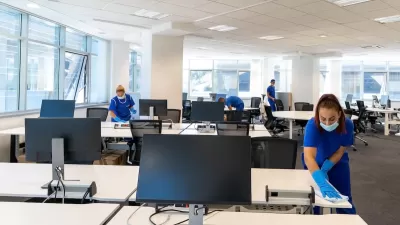The number of Americans whose commutes take over three hours per day peaked in 2019, but dropped dramatically as remote work became more widespread.

The number of Americans who travel more than 90 minutes each way to work, known as super commuters, has fallen to the lowest level in over 10 years, writes Chris Salviati for Apartment List. In 2021, just 3.1 million Americans were super commuters, down from a peak of 4.6 million in 2019.
“The number of remote workers more than tripled from 2019 to 2021. In 2019, just 5.7 percent of Americans worked primarily from home, but by 2021, that share jumped to 17.9 percent.” This led to shorter commutes overall, but “super commuters have seen the sharpest dropoff.”
According to the article, “Workers who rely on public transit to get to work are more than three times as likely to be super commuters as those who commute by car; 6.8 percent of all transit riders were super commuters in 2021, compared to 2.1 percent of drivers.”
Salviati also notes that “there is very likely a sizeable population of ‘part-time super commuters’ who we are not able to cleanly identify in this report” who don’t commute every day. The availability of hybrid arrangements may make super commuting more attractive, with workers only having to make the trip two or three times a week rather than daily.
FULL STORY: The Number of "Super Commuters" Has Fallen to the Lowest Level in Over a Decade

Alabama: Trump Terminates Settlements for Black Communities Harmed By Raw Sewage
Trump deemed the landmark civil rights agreement “illegal DEI and environmental justice policy.”

Planetizen Federal Action Tracker
A weekly monitor of how Trump’s orders and actions are impacting planners and planning in America.

Why Should We Subsidize Public Transportation?
Many public transit agencies face financial stress due to rising costs, declining fare revenue, and declining subsidies. Transit advocates must provide a strong business case for increasing public transit funding.

Understanding Road Diets
An explainer from Momentum highlights the advantages of reducing vehicle lanes in favor of more bike, transit, and pedestrian infrastructure.

New California Law Regulates Warehouse Pollution
A new law tightens building and emissions regulations for large distribution warehouses to mitigate air pollution and traffic in surrounding communities.

Phoenix Announces Opening Date for Light Rail Extension
The South Central extension will connect South Phoenix to downtown and other major hubs starting on June 7.
Urban Design for Planners 1: Software Tools
This six-course series explores essential urban design concepts using open source software and equips planners with the tools they need to participate fully in the urban design process.
Planning for Universal Design
Learn the tools for implementing Universal Design in planning regulations.
Caltrans
Smith Gee Studio
Institute for Housing and Urban Development Studies (IHS)
City of Grandview
Harvard GSD Executive Education
Toledo-Lucas County Plan Commissions
Salt Lake City
NYU Wagner Graduate School of Public Service





























